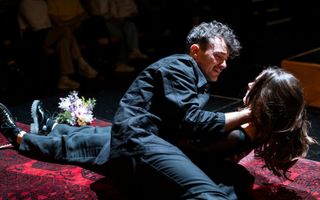 On Stage
On Stage
- Shakespeare wasn’t the originator of the Romeo and Juliet story. There were several earlier versions and references, but Shakespeare’s closest source material was a long-form poem by Arthur Brooke (which was in itself a translation of other previous versions of the story). Where Brooke’s poem had the story play out over several months and served as a warning for young people to obey their parents, Shakespeare compacted the action into less than one week, and removed the judgement of its two central characters.
- There isn’t any factual evidence that Romeo and Juliet were real people or that the story is true. There were however two feuding Italian families called the Montecchi and the Capuleti who were in a political struggle, and who are referenced in literature including by Dante (much earlier than Shakespeare). These names were likely to be Shakespeare’s inspiration for the names Capulet and Montague.
- The play contains one of the most misunderstood lines in all of Shakespeare - “O Romeo, Romeo, wherefore art thou Romeo?” (Juliet, Act 2, Scene 2) The line is commonly misinterpreted as meaning “Where are you, Romeo?” In actual fact, Juliet’s line means “Why are you Romeo?” referring to Romeo’s family name being a barrier to their love.
- The famous ‘balcony scene’ (Act 2, Scene 2) didn’t necessarily take place on a balcony. In the original text, Shakespeare writes that Juliet appears “at her window, above” which has led people to assume she is on a balcony, though there is no proof of this.
- In the Italian city of Verona where the play is set, there was a bronze statue of Juliet built in the 1970’s. Tourists made pilgrimage to the statue and rubbed Juliet’s right breast for good luck in love. After decades of hopeful visitors touching the statue, it had to be removed and replaced with a replica due to significant wear and tear.
- The word ‘Romeo’ has entered our modern lexicon, the definition of which is of a male romantic, or man synonymous with being a lover of women.
- ‘Romeo’ and ‘Juliet’ are the words that denote the letters ‘R’ and ‘J’ in radiotelephony or the NATO Phonetic Alphabet, famously used by the military.
- While there are countless modern-day Romeo and Juliet parodies, Shakespeare is believed to have parodied his own play in A Midsummer Night’s Dream. At the conclusion of the play, the Mechanicals’ overly dramatic, tragic love story is commonly believed to be Shakespeare echoing Romeo and Juliet’s romance and tragic end.
- Romeo and Juliet is a play that has spawned many adaptations across a wealth of artforms. These include:
Musicals: Leonard Bernstein’s West Side Story (1957)
Film: Franco Zefferelli’s film adaptation (1968), Baz Lurhmann’s Romeo + Juliet (1996)
Film adaptations: Zombie film Warm Bodies (2013)
Ballet & orchestral music: Sergei Prokofiev’s 1938 ballet of the same name
Songs: Dire Straits’ Romeo and Juliet (1981), Taylor Swift’s Love Story (2008)
Kids films: Gnomeo and Juliet (2011)






